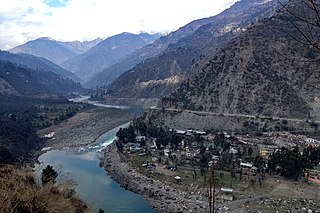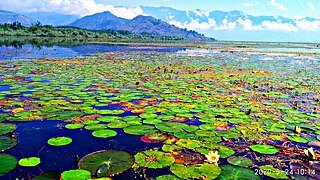Related Research Articles

The Chenab River is a major river that flows in India and Pakistan, and is one of the 5 major rivers of the Punjab region. It is formed by the union of two headwaters, Chandra and Bhaga, which rise in the upper Himalayas in the Lahaul region of Himachal Pradesh, India. The Chenab flows through the Jammu region of Jammu and Kashmir, India into the plains of Punjab, Pakistan, before ultimately flowing into the Indus River.

The Mangla Dam is a multipurpose dam situated on the Jhelum River in the Mirpur District of Azad Kashmir, Pakistan. It is the sixth-largest dam in the world. The village of Mangla, which sits at the mouth of the dam, serves as its namesake. In November 1961, the project's selected contractors were revealed; it was announced that Binnie & Partners, a British engineering firm, was going to serve as the lead designers, engineers, and inspectors for the construction of the dam. The project was undertaken by a consortium known as the Mangla Dam Contractors, which consisted of eight American construction firms sponsored by the Guy F. Atkinson Company based in South San Francisco, California.
Topi is a town in the eastern part of the Swabi District of Khyber Pakhtunkhwa province of Pakistan. The administrative division of Topi unfolds into two Union councils: Topi East and Topi West. Notably, the Tarbela Dam, largest earth-filled dam in the world, is located only 9 kilometres (5.6 mi) east of Topi.

Tarbela Dam is an earth-filled dam along the Indus River in Pakistan's Khyber Pakhtunkhwa province. It is located mainly in the Swabi District Tehsil Topi of the province. It is about 20 km (10 mi) from the city of Swabi KPK, 105 km (65 mi) northwest of Islamabad, and 125 km (80 mi) east of Peshawar. It is the largest earth-filled dam in the world. The dam is 143 metres (470 ft) high above the riverbed and its reservoir, Tarbela Lake, has a surface area of approximately 250 square kilometres (97 sq mi).

Wular Lake, also known as Wolar in Kashmiri, is one of the largest fresh water lakes in South Asia. It is located near Bandipora town in the Bandipora district of Jammu and Kashmir, India. The lake basin was formed as a result of tectonic activity and is fed by the Jhelum River and stream Madhumati and Arin.
The Kalabagh Dam is a proposed hydroelectric dam on the Indus River at Kalabagh in the Mianwali District, Punjab, Pakistan, which has been intensely debated along ethnic and regional lines for over 40 years.

The Neelum River, or Kishanganga River, is a river in the Kashmir region of Pakistan and India. It originates in Ganderbal district of Jammu and Kashmir in India, flows through the Neelam Valley in Pakistan's Azad Kashmir, where parts of its course fall along the Line of Control, before merging with the Jhelum River near the city of Muzaffarabad.

Gomal Zam Dam is a multi-purpose gravity dam in South Waziristan Tribal District of Khyber Pakhtunkhwa, Pakistan. The dam impounds the Gomal River, a tributary of the Indus River, at Khjori Kach, where the Gomal River passes through a narrow ravine. The purpose of the dam is irrigation, flood control, and hydroelectric power generation. Construction of the dam began in August 2001 and was completed in April 2011. The powerhouse was completed in March 2013 and electricity production started in August 2013. The dam was officially inaugurated on 12 September 2013 by Minister for Water and Power Khawaja Muhammad Asif, along with US Ambassador Richard G. Olson and Khyber Pakhtunkhwa Governor Shaukatullah Khan.
Diamer-Bhasha Dam is a concreted-filled gravity dam, in the preliminary stages of construction, on the River Indus between Kohistan district in Khyber Pakhtunkhwa and Diamer district in Gilgit Baltistan, Pakistan administered Kashmir. Its foundation stone was laid by the then Prime Minister of Pakistan in 1998. The dam site is situated near a place called "Bhasha", hence the name which is 40 km downstream of Chilas town and 315 km from Tarbela Dam. The eight million acre feet (MAF) reservoir with 272-metre height will be the tallest roller compact concrete (RCC) dam in the world.

The Bear River is a tributary of the Feather River in the Sierra Nevada, winding through four California counties: Yuba, Sutter, Placer, and Nevada. About 73 miles (117 km) long, the river flows generally southwest through the Sierra then west through the Central Valley, draining a narrow, rugged watershed of 295 square miles (760 km2).
Mohmand Dam is an under construction multi-purpose concrete-faced rock-filled dam located on the Swat River approximately 37 km north of Peshawar and 5 km upstream of Munda Headworks in Mohmand District, Khyber Pakhtunkhwa, Pakistan.

Garuk Dam is a proposed dam located on Garuk River, 47 km south east of Kharan District in Balochistan, Pakistan. The dam is an earth core rockfilled dam with a height of 184 feet. The reservoir when completed will irrigate a command area of 12,500 Acres and will have hydro-power capacity of 300 KW.
Hingol Dam is a proposed small, low-head, Central Core Zone, hydroelectric power generation dam of 3.5 megawatt (MW) generation capacity, located in the Lasbela District across the Hingol River in the Balochistan province of Pakistan. It is located at a distance of 260 km (162 mi) northwest of Karachi and about 16 km (10 mi) north of bridge across the Hingol River on the Makran Coastal Highway and about 8 km (5 mi) north of Kund Malir where the river falls into the sea.
Sabakzai Dam is an embankment dam on the Sawar Rud, a tributary of Zhob River, about 68 km southwest of Zhob in Balochistan, Pakistan.
Sukleji Dam is a proposed dam, to be located across Sukleji River in Kachhi District of Balochistan Province, in southwestern Pakistan.
Winder Dam is a proposed small, low-head, earth core rockfill, hydroelectric power generation dam of 0.3 megawatt (MW) generation capacity, located across Winder River about 100 km from Karachi in Lasbela District, Balochistan province of Pakistan.
The Kurram Tangi Dam is a multipurpose dam under construction on the Kaitu River in North Waziristan, Pakistan, with a 83.4 MW power generation capacity.
Bara Dam is a proposed small, low-head, earth core rockfill, hydroelectric dam with a capacity of 5.8 megawatts, located across Bara River at the confluence of Mastura River in Tirah Valley, Khyber Agency, FATA, Pakistan. It is part of a wider plan that consists in remodeling the Bara River, to promote agriculture.
Mangi Dam is located near Ziarat in Balochistan, Pakistan. The dam was constructed in 1982 and has a height of 18 m (59 ft) and storage capacity of 130,000 m3 (105 acre⋅ft). It was constructed at a cost of US$36.88 million. It was made to stop the fish from leaving the fishing area. In 2015 it is announced that the dam will also produce electricity and the shortage of load shedding will also reduce.
References
- ↑ "PELAR DAM PROJECT". Wapda, Govt. of Pakistan. Archived from the original on 10 June 2012. Retrieved 6 July 2012.
- ↑ "Funds for dozens of power projects, dams stopped". Dawn News. 12 May 2011. Retrieved 6 July 2012.
